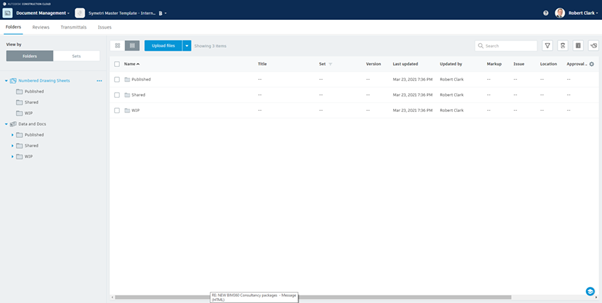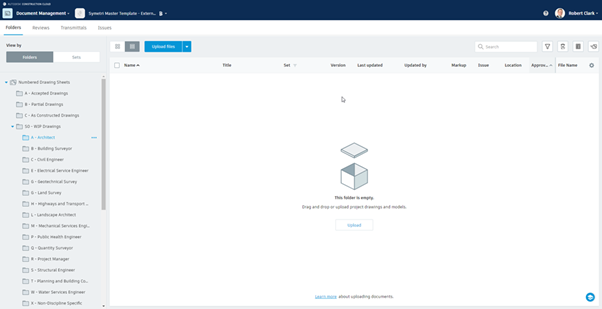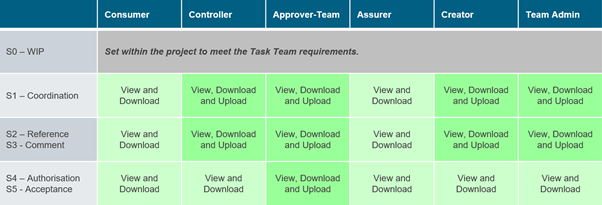This blog covers my opinion on the value of setting up ISO 19650 requirements within BIM 360 and Autodesk Construction Cloud Unified service (ACC).
What is ISO 19650-2:2018?
Let us start with a quick reminder of what ISO 19650-2:2018 is. It is a 26-page internationally appliable standard, with a 9-page UK National Annex by the International Organisation for Standardisation (ISO) body and locally the British Standards Institute (BSI). It provides us with a structured procedure for Information Management within the design and construction process. It does this to deliver trustworthy information to enable better decision-making and collaboration within the project lifecycle.
It also helps us provide information for operational use, creating a digital and importantly, consistent, and reliable integrable record regardless of where the information originates. In some situations, owners and operators use this information in computer-aided facilities management solutions (CAFM) that can be both used for enabling reactive maintenance and, to provide reliable data to, for example, tenants and regulatory bodies. The information can even be combined with live ongoing use data to inform Digital Twins to optimise the performance of an asset day by day. For example, where we combine data relating to the heating and cooling systems within our building, with live occupancy data, we can analyse this data and predict the system loads allowing good decisions around scheduling and settings, improving not only the occupiers experience but also helping us achieve our sustainability targets.
We use this standard to inform agreement on the project execution procedures to achieve these goals. This of course goes well beyond just technology solution to roles, responsibilities, and workflows on a project. Where we reach these agreements on a project and can support them, we effectively have a ‘Common Data Environment (CDE)’ deployed.
It’s not “a nice to have” anymore. There is plenty of carrots here for all of us. Clear CDE processes on projects which makes available trustworthy information allows us all to work more efficiently, cost-effectively, make better decisions, and produce better customer outcomes. But it is worth saying, in my opinion, there is a stick as well: don’t implement and you are wasting money, time, providing an unnecessarily chaotic product to the customer and the biggest of all, compromising safety. Indeed, if you review the new Building Safety Bill which we believe may pass into law later this year (subject to Parliamentary debate) we believe there will be a clear legal requirement for digital information to be created, maintained, and retained for high-risk buildings. We absolutely should be able to make clear the systems and materials within residential tower blocks for example, and we should be searching for this in standardised databases populated from the design and construction process, not looking through the printed document and uncoordinated PDFs.
How do BIM 360 and Autodesk Construction Cloud Unified platforms relate to this?
ISO 19650-2:2018 provide us with clear information management standards. For example, it provides naming conventions for all of the documents and data sets that are used to provide our information, as well as workflows to ensure that the suitability of this information is understood at all times.
Autodesk BIM 360 and Autodesk Construction Cloud (ACC) can provide the toolbox that we need as a team to support these information procedures as part of our CDE. For example, it allows us to centralise, store, collaborate on and review and approve information, tagging them with suitability codes so everybody working on the information understands its use-case. Unlike traditional document management solutions, BIM 360 was built for the design and construction process, and so is particularly strong when working with graphical Building Information Model for example, including IFC, Revit, Civil 3D, etc. While other document management solutions certainly have some advantages over BIM 360 in the management of other Information Container types, which is why you often see an enterprise multi-solution approach to CDE, BIM 360 and ACC are the strongest in the market, by quite some way in my opinion for graphical collaboration. It provides a controlled and secure environment for our information with clear access control and it provides us with tools to enable multi-team collaboration. Last but not least, if you extend the solution to include the other BIM 360 or ACC services, it provides tools all within the same connected environment to use information with confidence in construction management, cost management, and asset management to name a few. It really is a swiss army knife of a solution.
With all the above in mind, we at Symetri have as been developing a range of exciting new Professional Services to work with our customers efficiently and cost-effectively to both Deploy the solution for new customers and also, help existing customers Adopt functionality, we have been thinking about how we might best align the requirements with ISO 19650 with BIM 360 and ACC. We considered many elements of configuration within the solutions and I want to take this opportunity to take you through some of our thoughts on these elements;
Folders
Love them or loathe them it is how the solution compartmentalises data. We can set access rights on folders, preventing one person from gaining access to a particular folder at all, while enjoying full editing rights on another. Functionally, our Work in Progress (WIP) Design Collaboration tools and Model Coordination tools, specifically uses folders to establish where the WIP and Shared information is located. It therefore, makes sense for us to structure our folder system based on the ISO 19650 concept of status and suitability. At the top of this, is the status of WIP, Shared, Published and Archived, however within this, we also have Suitability which tells us what use case the information is approved for, so for example, S1 - For Coordination, S2 - For Reference. This means we can trust the information we are using.
So, we need at least three folder containers, WIP, Shared, and Published. Archived, we could create within the project, but generally, we consider Archiving to be something we do at the project level on conclusion and as such, this would be handled in BIM 360 or ACC by archiving the project at the account admin level.

Now, with these three folders, we can set access rights differently for WIP, Shared, and Published.
Let us consider Access Rights for a moment, there are a couple of things to know:

- Access rights can be set for individuals, roles, and companies on a folder. Where we do this all subfolders of this top-level folder inherit the same access rights.
- Access rights do not just control if a person, role, or company can view the contents of a folder or not, but also what they are allowed to do with that information in that folder. So, for example, you may be allowed to View but not Edit.
Therefore, you need to ask yourself two key questions here.
- Do I need people to have different access capabilities information with different use-cases? 1. For example, if we want to allow people to ‘work’ within the S1 Coordination folder, i.e. edit, reference, mark up etc., whereas we would only like them to view the contents of the S5 - For Acceptance folder, then we need to have a folder system that breaks out the suitability codes so you can set different access rights.
- I need to be able to retain individual versions for different use cases? For example, you may wish to have a copy of the model as approved for comment by the appointing party (S3), while a more up-to-date version and more regularly updated version of this same model may exist within the S1 Coordination folders to facilitate the rapid design and construction collaboration between the Task Teams.
If not, my recommendation would be to follow the good old best practice of ‘keep it simple, ‘stupid!’ The simpler the folder system, the easier people are going to find it to navigate and the less opportunity there is for duplication that must be managed, documented, and controlled.
In the case your answer is No for both above questions, create folders for WIP, Shared, and Published and where your answer is Yes for either question, create subfolders under Shared and Published for the suitability codes.
Also, it is advisable where you are working with multiple teams, within the WIP folders to create discipline subfolders. Again, so you can provide different access rights to each team and prevent each other from accessing each other’s data. This also allows you to set up teams for the Autodesk BIM Collaborate Pro Design Collaboration functionality, whereas the Team folders are within the discipline-specific folders and the ‘Shared’ folder is set to the S1 folder.

Access Right Management
Another key area: who gets what access within the solution, and as importantly how this is determined and controlled in a way that doesn’t produce a significant project administration overhead, particularly for those who have to manage the Joiners, Movers and Leavers (JML) process for complex and sometimes multi-organisational teams. My recommendation here is to use standardised Roles, that you determine as the way for you to define access.
A BIM Manager is one organisation that often has a different set of roles and responsibilities to a BIM Manager in a different organization, and so I always find it difficult to define the level of access and control that we provide ‘BIM Managers’ within a multi-team environment. Instead, what I like to do is define ‘Use-case Personas’ for the solution. This can be reviewed project to project, but my suggestion to get you started is Consumer, Controller, Approver, Assurer, Creator, Team Admin and Project Admin and I often use these definitions;
- A Consumer is a person who requires access to the data but doesn't intend to manipulate it.
- A Controller is a person who adds data to the environment.
- An Approver would be a person responsible for checking data quality assurance within their team.
- An Assurer would be a person responsible for reviewing data to ensure that it is suitable for the stated use before sharing it with the wider project team. This person will also need to raise issues on data produced outside of their task team.
- A Creator is a person requiring the ability to edit or otherwise change data hosted by BIM 360, including deleting it and creating new versions. This would describe a CAD or BIM software user, or somebody editing documents within the BIM 360 environment.
- A Team Admin would be a person who will administrate access and membership for just their team where the environment is being used by multiple teams.
- A Project Admin would be the person responsible for the configuration of the project.
You should now be able to map an individual’s use of your BIM 360 / ACC environment against this and set it as a Role within the solution. The good news is that Roles have some powerful capabilities in BIM 360 and ACC, these are:
- You can assign a Default Role at the Account Membership level. This means that when a user is added to a Project, they will automatically get that role. It can be overridden from project to project.
- You can add Access rights by Role.
- You can add Role-Based Access Rights (and only Role-Based Access Rights!) to your BIM 360 Document Management template.
- You can add multiple roles per person in a project i.e. a creator can also be an approver etc.
The idea here is that you will set up your access rights on the folders using these roles so that you always understand everybody’s roles and responsibilities in your project and what access these affords them. It is worth mapping this out in a matrix before you implement and agree this with the delivery team. For example, the below image shows how I usually set it up in a multi-organisational team for the Shared container.

There is a lot to consider at the end of the day and I hope this blog gives you some food for thought and a push in the right direction. I’m always happy to hear critical feedback, so please get in touch by emailing info@symetri.co.uk or rob.clark@symetri.com if you want to discuss anything.
Now let’s go back to why I mentioned that I’m getting a professional in, an expert, somebody to take away the burden next week to decorate my house! I can do it myself, I can watch YouTube videos and read blogs and do a reasonable job, learning as I go along with a few mistakes along the way and probably a roll of paper wasted or two! But I want somebody to listen to what I want, understand, and then bring their experience, expertise, professionalism to complement this, point out what isn’t a great idea. I then, frankly, want them to take away the burden of actually implementing the task and I want them to, much more quickly, quietly and efficiently than I might, take away the task so that I can concentrate on what I enjoy, writing lengthy blog posts!
At Symetri we have a range of Professional Services, backed up by a team with 50 years of collective experience on this subject, supported by solutions for onboarding and support, with collateral and templates in hand. We can partner with you to help you efficiently deploy or adopt BIM 360 and Autodesk Construction Cloud functionality how you want us to. This includes using our Symetri ISO 19650 templates, which include all the folder systems and access rights I have talked about here, pre-configured, we can quickly and easily deploy into your BIM 360 and ACC environment, and we can both teach you how to effectively configure the solution to meet your business requirements, but also provide you with outsourcing services to actually handle some of the work involved in this.
If you would like to speak to us about using our Symetri BIM 360 / ACC template or wish to talk to us about how to Deploy BIM 360 or Adopt new functionality, please do contact us using the details below.
Thank you for reading. Do take a couple of minutes to have a look at our under two-minute video that covers what is included in our Symetri template.

Author
Rob Clark
Rob boasts over 25 years of industry experience, beginning as a technician in Structural, Architectural, and Civil professions at Atkins Global and Buro Happold. Since transitioning into consultancy in 2006 and joining Symetri in 2011 as Principal Technical Consultant, Rob has spearheaded numerous digital transformation initiatives. Initially focused on deploying BIM technologies, particularly Autodesk Revit, Rob has shifted his attention to information management technologies like Autodesk Construction Cloud (ACC) and M-Files.
Rob's expertise extends to guiding organisations in deploying enterprise-level IT solutions, particularly Electronic Document Management Systems (EDMS), adhering to stringent and latest industry standards such as ISO 19650. Notable among his recent clients are Heathrow Airport, RLB, and Capita, where he has been instrumental in driving digital transformation initiatives for several years. Currently managing multiple enterprise-level solution deployment projects for Symetri customers, Rob also conducts Business Process Reviews, leveraging his ability to listen to customers, develop clear and measurable requirements, and provide innovative solutions to complex challenges.








